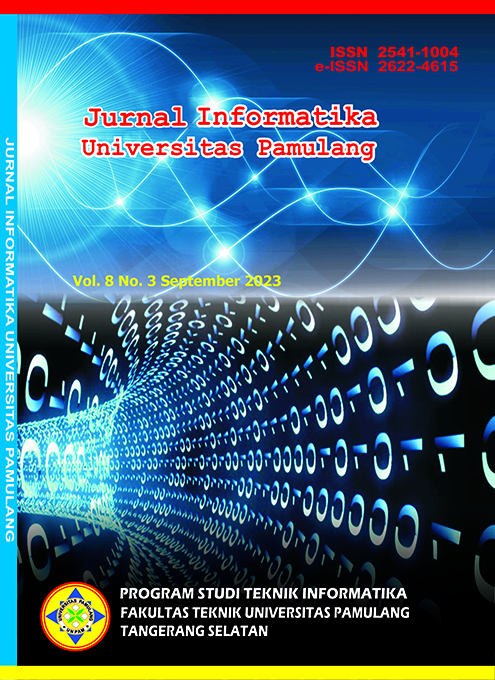Rancang Bangun Aplikasi Augmented Reality untuk Pembelajaran Materi Bangun Ruang Sekolah Dasar
DOI:
https://doi.org/10.32493/informatika.v8i3.33379Keywords:
solid space, geometry, augmented reality, addieAbstract
Geometry has emerged as a challenging topic in elementary mathematics due to its demand for solid cognitive capacities and spatial ability. Students struggle to understand geometry topics, particularly in solid space and three-dimensional objects. The students need help comprehending various three-dimensional shapes and understanding the formulas and definitions related to geometry. This paper aims to design and develop an application for learning solid space topics. The application provides explanations of solid space concepts, interactive exercises, and assessments to enhance students' understanding. The development process follows the ADDIE method, which includes Analysis, Design, Development, Implementation, and Evaluation. The application was evaluated by a mathematics teacher. We also conduct black-box testing. The result shows that all the functionality was valid and the application can be used by students. Future research will focus on implementing the application in actual mathematic classes and evaluating the impact on student learning.References
Alrehaili, E.A., & Osman, H.A. (2019). A Virtual Reality role-playing serious game for experiential learning. Paradigma Interactive Learning Environments, 30(5), 922-935.
Aulia, S.N., & Ruslan, H. (2019). Meningkatkan Kemampuan Siswa dalam Mengenal Bentuk-Bentuk Geometri dengan Bermain Balok Bangunan Pada Siswa SD Negeri 5 Hu’u Tahun Pelajaran 2019/2020. Jurnal Ilmiah Ilmu Pendidikan, 2(2), 268-272.
Bata, J. & Anggipranoto, E.V.B. (2023). Pengembangan Aplikasi Virtual Reality untuk Pembelajaran Bangun Ruang Kelas V Sekolah Dasar Menggunakan Model ADDIE, Jurnal Ilmiah Ilmu Pendidikan, 6(2), 826-832.
Branch, R.M. (2009). Instructional Design: The ADDIE Approach. Springer Science+Business Media, LLC.
Hsu, Y.-C. (2020). Exploring the Learning Motivation and Effectiveness of Applying Virtual Reality to High School Mathematics. Universal Journal of Educational Research, 8(2), 438-444.
Ibili, E., Cat, M., Resnyansky, D., Sahin, S. & Billinghurst, M. (2020). An Assessment of Geometry Teaching Supported with Augmented Reality Teaching Materials to Enhance Students’ 3D Geometry Thinking Skills. International Journal of Mathematical Education in Science and Technology, 51(2), 224-246.
Ismail, H., Abdullah, A.H., Alhassora, N.S.A., & Nohseth, N.H. (2020). Investigating Student’s Learning Difficulties in Shape and Space Topic: A Case Study. International Journal of Psychosocial Rehabilitation, 24(5), 5315-5321
Novita, R., Prahmana, R.C.I, Fajri, N. & Putra, M. (2018). Penyebab Kesulitan Belajar Geometri Dimensi Tiga. Jurnal Riset Pendidikan Matematika, 5(1), 18-29.
RodrÃguez, J.L., Romero, I. & Codina, A. (2021). The Influence of NeoTrie VR’s Immersive Virtual Reality on the Teaching and Learning of Geometry, Mathematics, 9(19), 2411, 1-22.
Rossano, V., Lanzilotti, R., Cazzolla, A. & Roselli, T. (2020). Augmented Reality to Support Geometry Learning. IEEE Access, 8, 107772-107780.
Downloads
Published
Issue
Section
License
Copyright (c) 2023 Marcel Antonio, Julius Bata

This work is licensed under a Creative Commons Attribution-NonCommercial 4.0 International License.
Authors who publish with this journal agree to the following terms:
- Authors retain copyright and grant the journal right of first publication with the work simultaneously licensed under a Creative Commons Attribution-NonCommercial 4.0 International (CC BY-NC 4.0) that allows others to share the work with an acknowledgement of the work's authorship and initial publication in this journal.
- Authors are able to enter into separate, additional contractual arrangements for the non-exclusive distribution of the journal's published version of the work (e.g., post it to an institutional repository or publish it in a book), with an acknowledgement of its initial publication in this journal.
- Authors are permitted and encouraged to post their work online (e.g., in institutional repositories or on their website) prior to and during the submission process, as it can lead to productive exchanges, as well as earlier and greater citation of published work (See The Effect of Open Access).
Jurnal Informatika Universitas Pamulang have CC-BY-NC or an equivalent license as the optimal license for the publication, distribution, use, and reuse of scholarly work.
In developing strategy and setting priorities, Jurnal Informatika Universitas Pamulang recognize that free access is better than priced access, libre access is better than free access, and libre under CC-BY-NC or the equivalent is better than libre under more restrictive open licenses. We should achieve what we can when we can. We should not delay achieving free in order to achieve libre, and we should not stop with free when we can achieve libre.
Jurnal Informatika Universitas Pamulang is licensed under a Creative Commons Attribution-NonCommercial 4.0 International (CC BY-NC 4.0)
YOU ARE FREE TO:
- Share : copy and redistribute the material in any medium or format
- Adapt : remix, transform, and build upon the material for any purpose, even commercially.
- The licensor cannot revoke these freedoms as long as you follow the license terms





